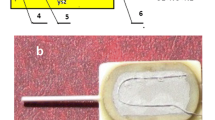Abstract
Potentiometric CO2 sensors based on the Na+ conducting solid electrolyte Nasicon have been investigated. The sensor arrangement may be described as chemical sensor of type III,
, with Na0.9CoO2 as reference electrode and Na2CO3 as auxiliary or sensing electrode.
It is shown that major problems are related to the magnitude of the voltage and long-term stability of this type of sensor. The measured EMFs are generally reduced compared to the values calculated from literature data of standard Gibbs energies of formation. This observation is ascribed to reactions at the interfaces and competing surface reactions. The interfacial processes may occur at both electrolyte / sensing and electrolyte / reference electrode, and represent charged capacitors. It has also been observed that the slope of the measured EMF as a function of the CO2 partial pressure is reversed in some cases. This phenomenon may be related to the possible reduction of Na2O which is dissolved in Nasicon during the formation of Na2CO3 upon an increase of the CO2 partial pressure.
Similar content being viewed by others
References
W. Weppner, Deutsche Patenschrift DE 2926172 (June 28, 1979).
G. Hötzel, Ph.D. Thesis, University of Stuttgart, 1986; G. Hötzel and W. Weppner, Proc. 6th Risø Int. Symp. on Transport-Structure Relations in Fast Ion and Mixed Conductors, Risø, Denmark, 1985, pp. 401–406.
S. Yao, Y. Shimizu, N. Miura and N. Yamazoe, Chem. Lett. 2033 (1990).
N. Miura, S. Yao, Y. Shimizu and N. Yamazoe, J. Electrochem. Soc.139, 1384 (1992).
N. Miura, S. Yao, Y. Shimizu and N. Yamazoe, Jpn. J. Appl. Phys.31, L197 (1992).
R.V. Kumar, Ionics5, 194 (1999).
N. Miura, S. Yao, Y. Shimizu and N. Yamazoe, IEEE, 558 (1991).
T. Ogata, S. Fujutsu, M. Miyayama, K. Koumoto, H. Yanagida, J. Materials Science Letters5, 285 (1986).
M. Ito and Z. Kozuko, Trans. of the Jpn. Inst. of Metals26, 17 (1985).
P. Pasierb, S. Komornicki, R. Gajerski, S. Kozinski and M. Rekas, Solid State Ionics157, 357 (2003).
H. Schettler, J. Liu, W. Weppner and R.A. Huggins, Appl. Phys. A57, 31 (1993).
W. Weppner, Solid State Ionics40/41, 369 (1990).
W. Weppner, Solid-State Devices II, Ceramic Sensors, Proceedings Volume 2000–32, The Electrochemical Society, Inc., Pennington, NJ, USA, 2001, p. 270–297.
W.F. Chu and D. Fischer, in: GBF Monographs, Vol. 13 (R.D. Schmid and F. Scheller, Eds.) Gesellschaft für Biotechnologische Forschung, Braunschweig-Stöckheim, VCH Weinheim, 1989, p. 179.
I. Barin, Thermochemical Data of Pure Substances, VCH, Weinheim, 1993.
T. Maruyama, S. Sasaki and Y. Saito, Solid State Ionics23, 107 (1987).
E. Steudel, Dr.-Ing. Thesis, Faculty of Engineering, University Kiel, 1998.
Author information
Authors and Affiliations
Rights and permissions
About this article
Cite this article
Chu, W.F., Tsagarakis, E.D., Metzing, T. et al. Fundamental and practical aspects of CO2 sensors based of nasicon electrolytes. Ionics 9, 321–328 (2003). https://doi.org/10.1007/BF02376581
Received:
Accepted:
Issue Date:
DOI: https://doi.org/10.1007/BF02376581




